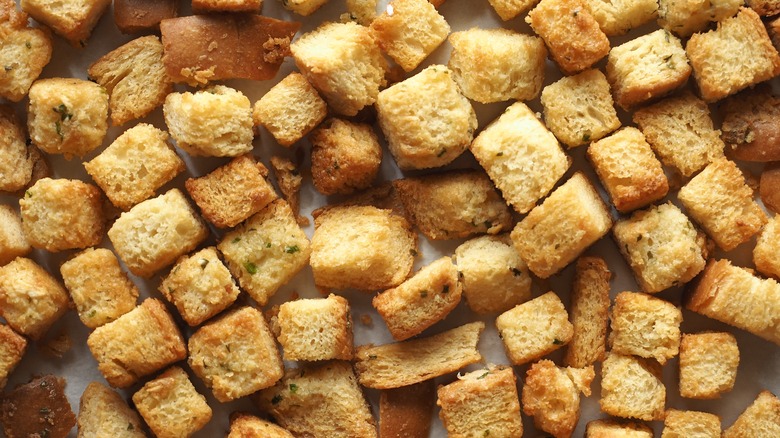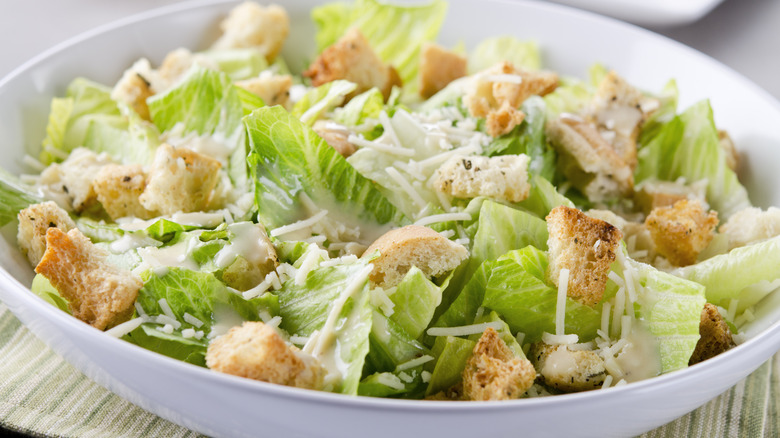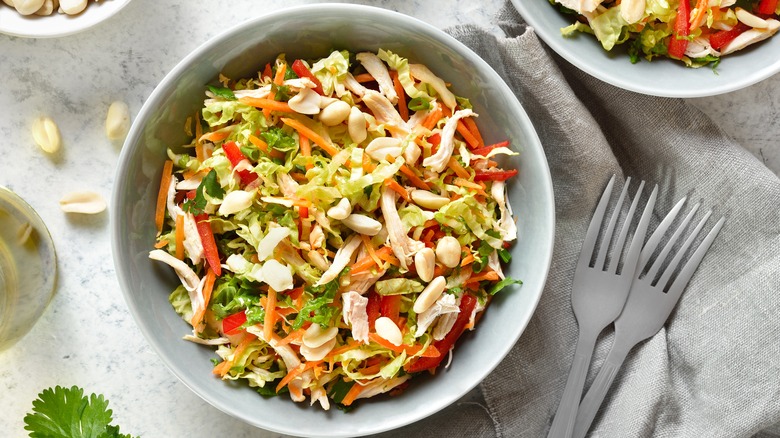Timing Is Everything When Adding Croutons To Your Salad
Ensuring croutons stay crunchy is simple, and it all has to do with timing. Croutons should be the last thing that goes on your salad — add them in right before you sit down to eat, and not a moment earlier. The longer the croutons sit on the salad, the longer the water in the veggies, dressing, and air has to seep in. Either sprinkle them on top just before serving or provide them on the side in a bowl for diners to serve themselves.
Ending up with soggy croutons has happened to the best of us. There's not much worse than expecting to bite into a crisp little square of buttery bread and being met with a soft, sad lump atop your salad instead. Soggy croutons often happen with leftover salad or prepackaged salads that have been sitting for a while. But they can also occur if you've prepped your salad too early and let it sit in the bowl for too long; the croutons take on moisture, and the crisped-up bread goes soft. Luckily, this is a salad mistake that's easily avoided.
Why croutons get soggy (and how to prevent it)
What causes croutons to get soft and soggy so quickly? The toasting process for croutons removes moisture from the bread, causing it to become hard and crispy. When moisture is re-introduced to the croutons by way of the water content from vegetables or dressing, the starch and sugar in the croutons suck in the moisture and, essentially, rehydrate themselves. Much like any other dried foods placed in liquid, given enough time, the croutons will reconstitute — softening and then becoming soggy.
While this process happens quickly once wet ingredients are introduced to a salad, it can also happen slowly outside of the salad if your croutons aren't stored properly. This is why using an airtight food storage container is key.
Always store your croutons separately from any other ingredients; they can be stored at room temperature for two weeks or in the fridge for three to four weeks. If you don't plan on eating them immediately, you can always freeze them for up to six weeks as well. And if you're using homemade croutons, be sure they're fully cool before storing, or the condensation from the heat can rehydrate them in storage.
Keep all crunchy toppings separate
Adding croutons right before eating is a rule that applies not just to these toasty little breads but to many other crunchy salad toppings as well. For the best results, keep all fried, toasted, and otherwise crisped-up ingredients off your salad until you're ready to serve.
This includes toppings like fried onion straws, parmesan crisps, tortilla strips, and crisped-up bacon, all of which can and will start to absorb moisture once added to a salad. Even toppings like nuts will absorb moisture over time, especially in humid environments — like your salad bowl.
The best way to keep all these ingredients crisp and fresh is to wait to add them, just like the croutons. If you're dying to have a picture-perfect salad in your serving bowl, add the crunchy parts right before calling everyone to the table. But if you're willing to give up the aesthetic, the best way to serve up these toppings is to keep them in separate bowls and let people add their own.
That way, any leftovers can be easily sealed and saved for later without getting covered in dressing or soaking in the moisture from greens and other veggies. And while you're at it, keep the dressing on the side to prevent soggy salad leftovers.


